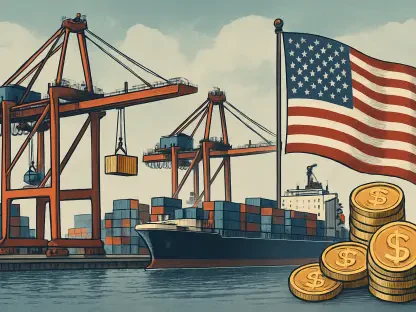Diving into the complex world of air cargo and international freight, I’m thrilled to sit down with Rohit Laila, a seasoned veteran with decades of experience in logistics and supply chain management. With a career spanning supply chain intricacies and delivery innovations, Rohit has a unique perspective on the evolving landscape of global trade. He’s also deeply passionate about how technology can transform the industry. In this conversation, we’ll explore the recent trends in air cargo spot rates, the impact of shifting trade flows, rising demand amidst uncertainty, and the ripple effects of regulatory changes like the U.S. de minimis ban on e-commerce shipments. Let’s unpack these pressing issues and gain insights into what’s shaping the future of air freight.
Can you walk us through what’s driving the recent drop in global air cargo spot rates, which fell 3% year over year to $2.55 per kilogram in August?
Certainly. The decline in spot rates is largely tied to a mix of economic uncertainty and shifting trade patterns. We’re seeing softer demand in some key markets due to broader economic concerns, which puts downward pressure on pricing. Additionally, there’s been a noticeable redirection of trade flows, especially with e-commerce shipments from China moving more toward Europe rather than the U.S. This shift dilutes the global average rate since some of these routes have lower pricing structures. It’s also worth noting that currency fluctuations play a role—when rates are converted to U.S. dollars, which have weakened against other currencies, the drop appears even steeper.
How significant is economic uncertainty in contributing to this decline in spot rates?
Economic uncertainty is a major factor. When businesses and consumers are unsure about the future—whether due to inflation, geopolitical tensions, or other global issues—they tend to scale back on spending and inventory buildup. This directly impacts the demand for air cargo, which is often used for high-priority or time-sensitive goods. Shippers become more cost-conscious, opting for cheaper alternatives like ocean freight when possible, which further pressures air cargo rates downward. It’s a cycle of caution that’s hard to break until there’s more clarity in the global economy.
What impact has the shift in trade flows, particularly e-commerce shipments moving from China to Europe instead of the U.S., had on these rates?
The redirection of e-commerce shipments from China to Europe instead of the U.S. has had a noticeable impact. Historically, the U.S. was a massive market for these goods, often commanding higher spot rates due to demand and distance. But with recent policy changes like the de minimis ban in the U.S., a lot of volume has shifted to Europe, where rates are often lower due to shorter distances and different market dynamics. This reallocation drags down the global average spot rate, as the higher-rate corridors lose volume while lower-rate ones gain.
Despite falling rates, air cargo demand increased by 5% year over year in both July and August. What’s fueling this growth?
The growth in demand, even with falling rates, is quite interesting. A big driver is the modal shift we’re seeing—shippers who typically use ocean freight are switching to air for specific needs, like avoiding delays or tariffs. E-commerce continues to play a huge role as well, with consistent demand for fast delivery of consumer goods. Additionally, certain industries are ramping up their use of air freight to meet urgent supply chain needs, especially in tech and retail, where timing is everything. It’s a bit of a paradox, but it shows how flexible shippers are adapting to current challenges.
Which industries or types of shippers are contributing most to this demand increase?
E-commerce is undoubtedly at the forefront, with online retail giants and smaller platforms alike pushing for faster delivery to meet customer expectations. Beyond that, the technology sector is a significant contributor—think electronics and components that need to move quickly to keep production lines running. Retail, especially fashion and seasonal goods, also plays a big part as companies stock up for peak periods. Then there’s the group of shippers who swing between ocean and air based on urgency or cost—these flexible players are really driving the uptick by opting for air when timing or tariffs make ocean less viable.
How important is the role of shippers who switch between ocean and air freight in sustaining this demand growth?
It’s incredibly important. These flexible shippers act as a kind of buffer in the market. When ocean freight faces disruptions—whether it’s port congestion, tariff issues, or longer transit times—they pivot to air to keep their supply chains moving. This adaptability has been a key driver behind the 5% demand growth we’ve seen. They’re not committed to one mode of transport, so their decisions are often reactive to immediate market conditions, making them a critical piece of the puzzle in maintaining air cargo volumes right now.
Even with this demand growth, there’s a sense of uncertainty in the market. Can you explain why it’s hard to feel confident about these positive numbers?
Absolutely. While the 5% growth is encouraging, it’s not enough to signal a robust, sustainable recovery. The uncertainty stems from a lack of visibility into what’s coming next—shippers and carriers alike are struggling to predict market conditions even a few weeks out. Economic headwinds, fluctuating consumer demand, and geopolitical factors keep everyone on edge. Plus, the growth isn’t evenly distributed; some regions or sectors might be booming while others lag, creating an uneven picture. It’s hard to bank on these numbers when the foundation feels so shaky.
What are the biggest concerns for shippers right now that could affect future demand?
Shippers are grappling with a few major concerns. First, there’s the ongoing economic uncertainty—will consumer spending hold up, or will we see a slowdown? Then there’s the impact of tariffs and trade policies, which can shift costs and routes overnight. Compliance with new regulations, like the U.S. de minimis changes, adds another layer of complexity and cost. And let’s not forget operational challenges—capacity constraints, labor issues, and rising fuel costs all weigh heavily. These factors make it tough for shippers to plan long-term, which could dampen air cargo demand if confidence doesn’t improve.
How does the lack of clarity about market conditions in the next few weeks impact decision-making for businesses in this space?
The lack of clarity creates a real dilemma for businesses. Without a clear picture of what the market will look like in even the near term, companies hesitate to commit to long-term contracts or big investments in capacity. Instead, they often make short-term, sometimes costlier decisions—like opting for air freight to avoid potential delays—because they can’t afford to get caught off guard. This reactive approach can lead to inefficiencies and higher expenses, and it keeps the market in a state of flux as everyone waits for more certainty before making bolder moves.
Shifting gears, can you elaborate on how the U.S. de minimis ban, which took effect on August 29, is affecting the air cargo market?
The removal of the de minimis exemption has created significant turbulence in the air cargo market, especially for e-commerce. This policy, which previously allowed low-value goods to enter the U.S. without certain taxes or duties, was a huge driver of air freight demand, particularly from China. Since its end, we’ve seen a drop in these shipments as compliance costs rise and the process becomes more cumbersome. It’s not just affecting direct-to-consumer goods; even business-to-business shipments are caught up in the new rules, slowing down volumes and reshaping trade patterns as shippers look for alternative markets or routes.
How are small- and medium-sized businesses specifically challenged by these de minimis changes?
Small- and medium-sized businesses are really feeling the pinch with the de minimis ban. Unlike larger corporations, they often lack the resources or infrastructure to navigate the new compliance requirements quickly. The added paperwork, costs, and delays can be a major burden, especially for those reliant on low-value, high-frequency shipments. Many are struggling to absorb these extra expenses or pass them on to customers without losing competitiveness. Some are even forced to rethink their entire supply chain strategy, which is no small feat for a business with limited bandwidth.
Why are postal carriers in countries like Canada, the UK, and Mexico restricting shipments to the U.S. due to these new compliance rules?
Postal carriers in countries like Canada, the UK, and Mexico are restricting U.S.-bound shipments because the new de minimis rules impose stricter compliance and documentation requirements that are tough to meet on a large scale. These carriers often handle huge volumes of small parcels, and ensuring each one meets the updated standards is a logistical nightmare. The risk of penalties or rejected shipments is high, so many are choosing to limit or halt services to avoid the headache. It’s a ripple effect that’s disrupting cross-border e-commerce flows beyond just China.
The de minimis changes, initially aimed at Chinese e-commerce platforms, are now impacting a broader range of shipments. How is this reshaping the competitive landscape?
What started as a targeted move against large Chinese e-commerce platforms has indeed broadened to affect a much wider range of shipments, creating a more level playing field in some ways. Shippers from all regions now face similar compliance hurdles when sending goods to the U.S., which reduces the cost advantage that some had under the old rules. This is reshaping competition by forcing everyone to adapt—some are finding new markets, while others are doubling down on efficiency to offset costs. It’s also shifting where air cargo demand is concentrated, as shippers reassess the profitability of U.S.-bound routes.
How does this leveling of the playing field specifically impact e-commerce shipments from Europe to the U.S.?
For e-commerce shipments from Europe to the U.S., this leveling of the playing field means they’re no longer at a relative disadvantage compared to shipments that previously exploited the de minimis loophole. However, it also means they face the same increased costs and compliance burdens as everyone else. As a result, we’re likely to see lower air cargo volumes from Europe to the U.S. in this sector, as the higher costs make some shipments less viable. Shippers might explore other modes or markets, or focus on consolidating shipments to manage expenses better.
Looking ahead, what is your forecast for the air cargo market in light of these ongoing challenges and uncertainties?
I think the air cargo market will remain in a state of flux for the near future. We’re likely to see continued volatility in spot rates as economic uncertainty and trade policy shifts keep playing out. Demand might hold steady or even grow slightly, driven by e-commerce and flexible shippers, but it won’t be the strong, sustainable growth the industry needs without clearer economic signals. The de minimis fallout will likely suppress some U.S.-bound volumes, pushing more trade to other regions like Europe or within Asia. Technology and data-driven solutions will be critical for shippers and carriers to navigate this uncertainty—those who adapt fastest will come out ahead. It’s going to be a bumpy ride, but there’s opportunity for innovation to drive resilience.









